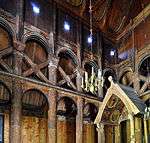Hopperstad Stave Church
| Hopperstad Stave Church | |
|---|---|
| Hopperstad stavkyrkje | |
|
View of the church | |
 Hopperstad Stave Church Location in Sogn og Fjordane county  Hopperstad Stave Church Location in Sogn og Fjordane county | |
| 61°04′38″N 6°34′08″E / 61.0773°N 6.5689°ECoordinates: 61°04′38″N 6°34′08″E / 61.0773°N 6.5689°E | |
| Location |
Vik Municipality, Sogn og Fjordane |
| Country | Norway |
| Denomination | Church of Norway |
| Churchmanship | Evangelical Lutheran |
| Architecture | |
| Status | Historic Parish church |
| Functional status | Preserved |
| Architect(s) | Original architect unknown; 19th-century restoration by Peter Andreas Blix |
| Architectural type | Stave church |
| Style | Romanesque and Gothic |
| Completed | c. 1130 |
| Specifications | |
| Capacity | 30 |
| Materials | Wood |
| Administration | |
| Parish | Vik |
| Deanery | Indre Sogn prosti |
| Diocese | Diocese of Bjørgvin |
Hopperstad Stave Church (Norwegian: Hopperstad stavkyrkje) is a stave church, just outside the village of Vikøyri in Vik Municipality, Sogn og Fjordane county, Norway. The church is currently owned by the Society for the Preservation of Ancient Norwegian Monuments. The two old parishes of Hopperstad and Hove was abolished in 1875, and replaced by the new, united, Vik parish. The new Vik Church was finished in 1877, and the two middle age churches of Hopperstad and Hove have sice then been museum churches. Vik parish is a part of Indre Sogn deanery in the Diocese of Bjørgvin.[1][2][3]
The stave church is assumed to have been built around the year 1130 and still stands at its original location. In 1997, a series of samples from the logs were collected for dendrochronological dating of the church. A total of seven samples produced an estimate for the construction ranging from 1034 to 1116 and resulted in no definite conclusion. The only possible conclusion is that this is one of the oldest stave churches still standing.
History
About 700 years after its construction the church was abandoned and its exterior stripped. The church was in very poor condition for many years until the Society for the Preservation of Ancient Norwegian Monuments purchased the building in 1880. Using the Borgund Stave Church as a model, architect Peter Andreas Blix reconstructed the church between 1884 and 1891. During the reconstruction carved sections were found beneath the floor which indicates that the new church replaced an older church, which was probably built in the latter half of the 11th century.[3]
The church had not undergone any major changes until the 17th century. At that time the nave was lengthened to the west, and a bell-tower was added above the new extension. To the east a log section was added, and a new vestibule to the south with its own entrance.
The largest addition came to the north with a log construction, named the new church (nykirken). The constructions were finalized in the 18th century, but then removed in around 1875. There are no known images of the interior from this time, but a story written by the priest Niels Dahl, who is assumed to have visited the church in 1824, describes the interior.[4]
The church has galleries at three levels around all of the walls, that the church [had a rundt alle veggene og at den var lavloftet og tømret] with staircases up to the galleries. And the font is placed under the medieval baldaquin. And the walls are painted by numerous quotes from the Holy Scripture in vivid colours.
Present building
The church is a triple-nave stave church of what is known as the Borgund-type. It has three portals, and the western portal is an excellent example of Middle Age wood carving. The motifs are of a romance character, often associated with European influence. The nave is a raised central room with an aisle around it, and the choir is apsidal and narrower than the nave.[4]
The church contains an altar dedicated to the Virgin Mary, and 14th-century ciborium with a baldachin on the north side. The ciborium has four sculptured heads, that of Christ with a halo, a queen, a king, and a monk. The roof of the baldachin bears a painting of the birth of Christ.[4]
There is a replica of the Hopperstad reconstruction at the Heritage Hjemkomst Center in the city of Moorhead in the state of Minnesota in the United States. It was consecrated in 1998.[3]
Media gallery
 Hopperstad in 1885 before restoration work
Hopperstad in 1885 before restoration work Dragon head
Dragon head Portal
Portal The church after the restoration
The church after the restoration Hopperstad stave church
Hopperstad stave church View from the east
View from the east View of interior with cimborium
View of interior with cimborium
References
- ↑ "Hopperstad stavkyrkje". Kirkesøk: Kirkebyggdatabasen. Retrieved 2014-01-27.
- ↑ "Oversikt over Nåværende Kirker" (in Norwegian). KirkeKonsulenten.no. Retrieved 2014-01-27.
- 1 2 3 "Hopperstad stavkyrkje" (in Norwegian). Sogn og Fjordane Fylkesarkiv. Retrieved 2014-01-27.
- 1 2 3 Valebrokk, Eva; Thiis-Evensen, Thomas (1993). Levende fortid. De utrolige stavkirkene (in Norwegian). Boksenteret. ISBN 978-82-7683-024-8.
| Wikimedia Commons has media related to Hopperstad stave church. |
External links
- Hopperstad stave church at stavkirke.info (Norwegian)
- Hopperstad stave church at Fortidsminneforeningen (Norwegian)
- Fortidsminneforeninga's stave church pages (Norwegian)